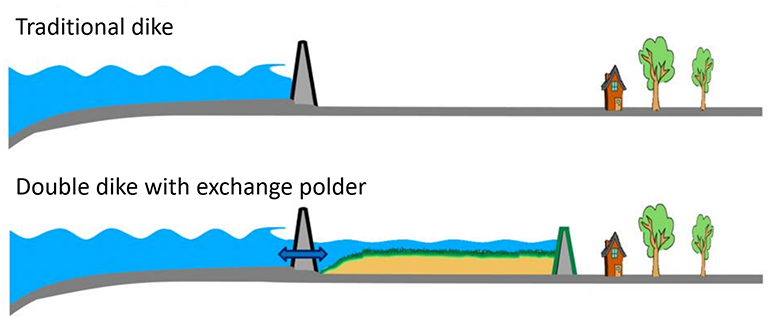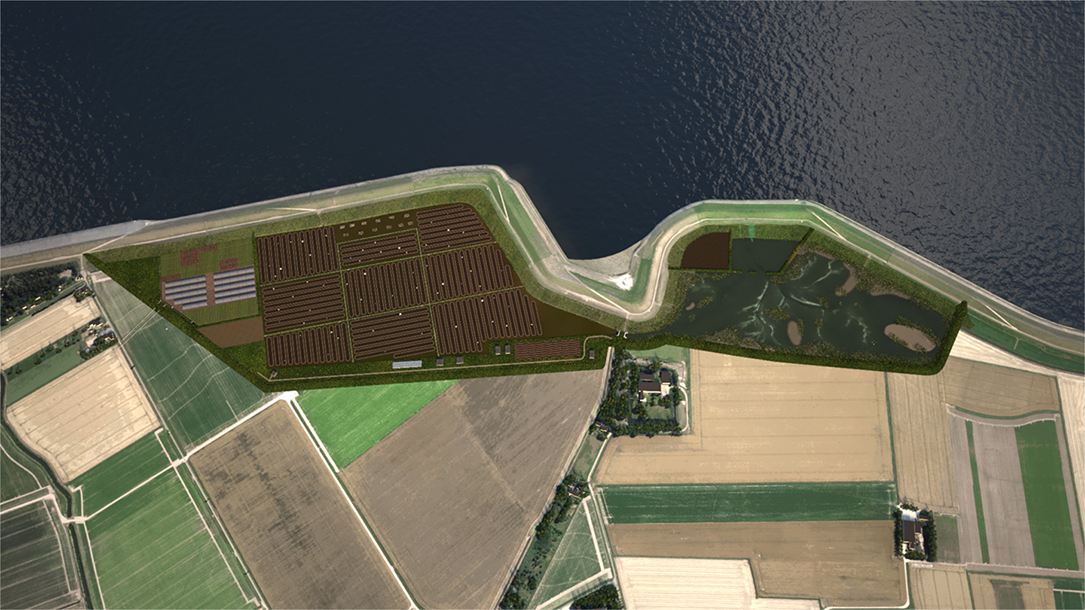Dikes
Dike constructions protect the Rhine-Meuse delta against river flooding and storm surges coming from the North-Sea. Dike failure is not always related to flooding but can also result from subsurface and groundwater mechanisms. This, together with the need for a more integral flood risk management approach, requires new, robust and multifunctional dikes.
Dike failure
Researchers at Utrecht University investigate multiple failure mechanisms of dikes.
| Subsurface-related dike failure mechanisms | Several dike failure mechanisms are related to the subsurface build-up, which shows a great spatial variability. However, current risk assessments rely on oversimplified subsurface properties. During his PhD project, Bas Knaake improves quantitative assessments of regional and local variability within different types of deposits via critical subsurface characteristics. |
| Piping in practice | At locations where a river dike overlies a subsurface permeable sand body, seepage pathways can emerge during flood periods, creating so called pipes which can ultimately trigger dike failure. In their PhD projects, Tim Winkels and Willem-Jan Dirkx make a step towards more functional hydrological characterisation of channel belts in 3D numeric subsurface flow and piping calculations by incorporating the heterogenic subsurface. |
| Groundwater-related dike safety | Groundwater flow is very important for various failure mechanisms of dikes, including piping and slope instability. In his PhD project, Teun van Woerkom aims for better understanding groundwater flow through and around river dikes and improving methods for estimating groundwater levels under high river water levels. |
Double dike
The concept
In the All-Risk project, researchers at the Water, Climate and Future Deltas hub collaborated with TU Delft, University of Twente, Wageningen University and Radboud University Nijmegen on research into the implementation of flood safety standards for flood defences and innovative multifunctional dikes. The project focussed on the Double Dike which was developed as an alternative to standard dike reinforcement and is currently being implemented on the north Dutch coast in Groningen. A combination of a reinforced first dike on the seaward side and a second new dike in the hinterland ensure flood protection. The area between the two dikes presents opportunities for clay mining, nature, recreation, floating housing, saltwater agriculture and can be used as an exchange polder.

In between the dikes
Exchange polders (in Dutch: “wisselpolders”), also called “transitional polders”, use natural sedimentation processes to raise land in between two dikes (Storyline: Retaining sediment). A temporary opening is made in the most seaward dike to allow tidal water to flow into the polder, while the second dike prevents the water from flowing further inland. By reconnecting polders to the tidal influx of water and sediment, they gradually silt up. In this way, exchange polders create an area of elevated land along the estuary, providing extra protection for the hinterland while at the same time creating new land for agriculture and nature. Tjeerd Bouma, professor of bio-geomorphological ecology of estuaries, deltas and coasts, explains, “Due to the high return on investment and the addition of new economic and natural functions to the landscape, exchange polders are a no-regret investment”.
Added value to flood risk management?
However, there is discussion about the added value of a double dike since it is currently not clear whether a second dike contributes to flood risk reduction. As a result of the All-Risk webinar about the Double Dike system in Groningen, Willemijn van Doorn-Hoekveld, researcher in public, water and liability law, and Marleen van Rijswick, professor of European and Dutch water law, therefore recommend "To first look at the intended goal and for which aspects the double dike creates an added value". From a long-term perspective, the area in-between the dikes could be used as an exchange polder to keep up with sea-level rise. This, however, challenges the compliance of flood safety standards in the short-term.

Determination of primary water defence
"It is therefore imperative to legally designate one or both of the two dikes as primary water defence to assess whether it meets these standards", explain Willemijn van Doorn-Hoekveld and Marleen van Rijswick. Theoretically only the inner dike must comply with the safety norms, whereas in current practice the dike with the largest contribution to flood risk reduction is preferred as primary water defence. From a juridical perspective, every option is possible, including the regulation of the inner dike as primary water defence with the outer dike and area in-between the dikes as foreland.

